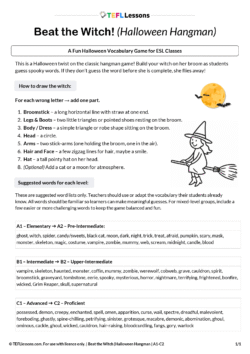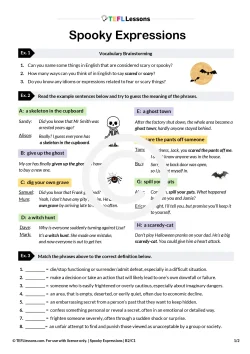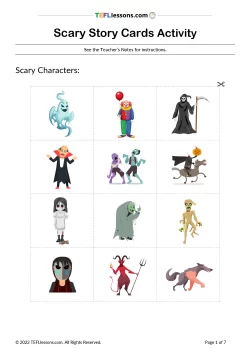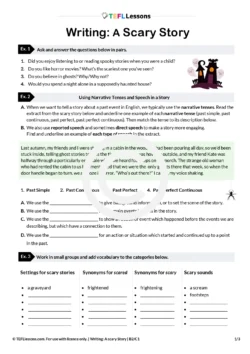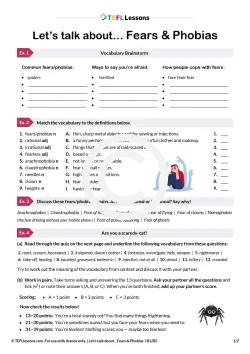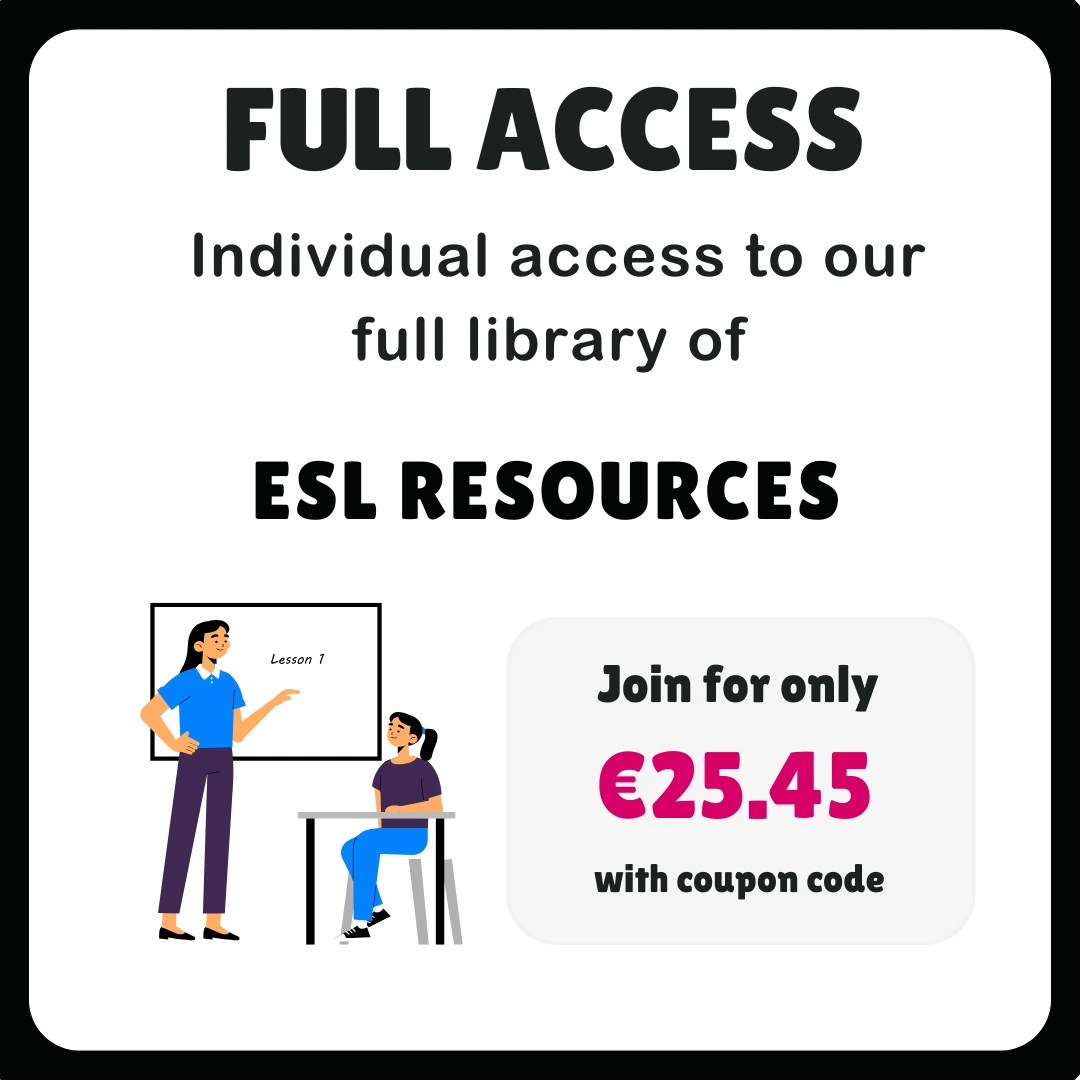Celebrate in Your Classroom with Our Fun, No-Prep or Low-Prep Halloween ESL Ideas and Resources!
Halloween is the perfect time to bring a little magic, mystery, and excitement into your ESL classroom! Whether you’re teaching teens or adults, this spooky season is a fantastic opportunity to boost vocabulary, spark conversation, and explore traditions — while keeping your learners engaged and having a frightfully good time.
To help you celebrate, we’ve gathered a mix of ready-to-use Halloween ESL games and activities for adults and teens, including four free classroom resources you can download today. You’ll find speaking tasks, vocabulary challenges, writing ideas, and creative, low-prep classroom fun your students will love.
🧡 Explore Our Halloween ESL Resources
REGISTER HERE TO ACCESS 100+ FREE ESL MATERIALS
🕸️ Halloween Classroom Ideas & Activities
💀 Halloween Vocabulary Activities & Speaking Games
Start with a Spooky Vocabulary Intro using our free Halloween Vocabulary Worksheet (A1–A2) or Halloween Vocabulary Lesson (A2–B1). Students match pictures to words, complete gap-fills, and chat about customs they know.
🧙♀️ Beat the Witch – Halloween Hangman
Bring some light-hearted competition into your class with Beat the Witch! — our free Halloween version of Hangman designed for ESL learners. Students race to guess spooky words before the witch flies away! 🧹
This adaptable game works with any vocabulary list — from simple Halloween words like pumpkin and ghost to trickier ones like tombstone or possessed. It’s flexible, fun, and needs no prep — just a whiteboard and marker.
🕷️ Spooky Spider Challenge
Review Halloween vocabulary with this quick, competitive team game! Give students spider diagrams with centre words like pumpkin, witch, ghost, vampire, or haunted house. In groups, they have 2–3 minutes to write six words connected to each. Afterwards, compare answers and award points for correct words and extra points for any unique words that no other team has. The team with the most creative connections wins!
🎃 Halloween Bingo or Quiz
Add friendly competition to your Halloween ESL games. Bingo: create simple cards in Word or Canva using words from recent lessons (witch, ghost, pumpkin, costume). Call out clues like “It flies on a broom!” Quiz or Kahoot!: make 10–15 questions mixing pop-culture and vocabulary (When is Halloween celebrated? What does a vampire hate?). Perfect for quick group play.
✍️ Creative Halloween Writing & Poetry
Encourage your students to use new vocabulary creatively this Halloween! Start with our Scary Story Cards – Creative Writing Activity or Writing a Scary Story ESL Lesson. Students brainstorm spooky vocabulary, plan characters and settings, and craft short tales while revising narrative tenses.
Next, explore rhythm and emotion through poetry. Read short excerpts from The Raven (Edgar Allan Poe, B2–C1) or The Spider and the Fly (Mary Howitt, B1), then have learners write their own Halloween poem, limerick, or rhyming spell — for example:
“By moonlit glow and candle bright,
Bring us laughter through the night!”
These creative writing tasks encourage imagination, reinforce grammar and vocabulary, and make writing lessons feel magical — perfect for adults or teens.
🎵 Halloween Music or Poetry Gap-Fills
Bring atmosphere to your lessons while practising listening, pronunciation, and rhythm. Use short lyric gap-fills or excerpts from Halloween-themed songs and poems.
- This Is Halloween – A2–B1: simple, repetitive vocabulary and clear pronunciation.
- Monster Mash – B2+: playful past-tense verbs and Halloween expressions.
- Thriller – B2–C1: vivid adjectives and narrative storytelling language.
You can also adapt poems like The Raven or The Spider and the Fly into short gap-fill or comprehension exercises. After listening or reading, discuss how rhythm, rhyme, and imagery create a spooky mood.
🧩 Halloween Crossword Challenge
Perfect for vocabulary review or homework! Use our printable crosswords to reinforce spelling and comprehension:
- Halloween Vocabulary Crossword (A2–B1) – a fun in-class or post-lesson task.
- Halloween ESL Crossword (B2) – a great way to challenge higher-level students after idioms or vocabulary lessons.
🎥 Movie Clip Listening & Discussion
Short clips make excellent Halloween activities for ESL students. Use Hocus Pocus, Coraline, or The Nightmare Before Christmas for lighter lessons, or The Others, Sleepy Hollow, Beetlejuice, or The Sixth Sense for adults. Students can:
- Watch and answer comprehension questions (they can even write their own!).
- Identify useful expressions from dialogue.
- Discuss characters, setting, and mood.
😱 Spooky Expressions – Idioms About Fear (B2–C1)
Introduce idioms such as scared stiff, frozen with fear, and a ghost town through matching and short dialogues with our Spooky Expressions – Idioms About Fear ESL Lesson. These spooky expressions make a great addition to your Halloween speaking activities and help students sound more natural when talking about fear and suspense.
💬 Discussion Questions About Halloween
Your Halloween Vocabulary Lessons (A1–B1) include ready-made questions to get learners talking about costumes, customs, and celebrations. For deeper conversation, use our Fears and Phobias lesson or adapt these prompts:
- What do you like or dislike about Halloween?
- Do you believe in ghosts or superstitions?
- How do people celebrate Halloween in your country?
🧛 Monster Modals – Spooky Survival Game
Practise modals and conditionals with these fun scenarios:
- You hear footsteps behind you on a dark road. What should you do?
- A witch offers to grant you one wish – what would you wish for?
- A vampire is trying to enter your house – what should you do?
- You wake up invisible – what could you do that day?
- All the graves in a graveyard have been dug up – what could have happened?
A light-hearted way to review should, could, would, and might while encouraging creative speech.
🎆 After Halloween: Teach Guy Fawkes Night
Keep the momentum going with our free Guy Fawkes Night ESL Lesson (B1–B2). Students explore this British tradition through vocabulary, listening, and discussion tasks — a perfect cultural bridge from Halloween into November.
🧡 Free Halloween Resources You Can Use Today
- Beat the Witch – Halloween Hangman
- Halloween Vocabulary A1–A2
- Halloween Vocabulary A2–B1
- Halloween ESL Crossword (B2)
- Guy Fawkes Night (B1–B2)
🎃 Explore More Halloween ESL Games & Resources
REGISTER HERE TO ACCESS 100+ FREE ESL MATERIALS
For best results when printing our PDFs, open and print them through Adobe Acrobat (Free).
